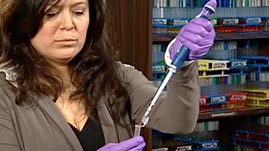Teachers' Domain - Digital Media for the Classroom and Professional Development
User: Preview

Source: Austin Community College and the Texas Education Agency: "How to Micropipet"
In these videos from Austin Community College, learn how to correctly and accurately transfer volumes of liquid from one vessel to another using a pipettor and a micropipettor. The primary video features three different micropipettors, which are color-coded according to the range of volume to be transferred. A lab technician demonstrates proper procedural technique—first selecting a micropipettor and adjusting its volume setting, then drawing and dispensing a sample liquid, and lastly, ejecting the tip. The secondary video also examines pipette aids, including pumps and bulbs, which are used to help draw up liquids.
A pipettor is a type of instrument used in chemistry and biology research to transfer a specific volume of liquid from one vessel to another. Pipettors are commonly used to make laboratory stock solutions and dilute these solutions to desired concentrations. A pipettor works by creating a vacuum above a vessel that contains the sample liquid and releasing this vacuum to draw up and dispense the liquid. Micropipettors dispense between 1 and 1000 microliters (µl), while macropipettors dispense a volume of 1 milliliter (ml) or more.
All pipettors are designed to be reliable and precise. As with other precision instruments, a pipettor must be well maintained and its operator must be competent. The operator must account for variations in temperature, pressure, and humidity, and make adjustments to equipment as needed. Operators need training in the correct use of pipettors, which may vary in construction. For example, glass pipettors generally use a rubber bulb to create the vacuum, which sucks the liquid into the pipette and also allows the operator to drain the pipettor in a controlled fashion. This takes practice. Other user errors can occur when operators are talking or not focused. For example, if pipettor tips are not disposed of and replaced after each use, they may cross-contaminate samples.
As precision lab instruments, pipettors require regular calibration. It is essential to verify pipettor performance frequently through routine functional checks and maintenance. The longer a defective pipettor remains in service, the greater the potential for measurement and delivery errors.
Errors caused by poor lab technique or defective equipment can impact data integrity, ruin an entire batch of product, or contaminate frequently used solutions. Wasting product, invalidating data, contamination, and having to repeat assays can be time-consuming and expensive. Inaccurate pipetting can also lead to problems with regulatory agencies if errors go unnoticed until after products have been released: this can seriously damage a laboratory's reputation.
 Loading Standards
Loading Standards Teachers' Domain is proud to be a Pathways portal to the National Science Digital Library.
Teachers' Domain is proud to be a Pathways portal to the National Science Digital Library.
